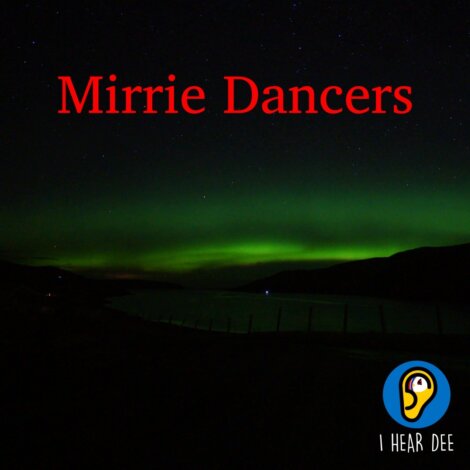Community / History in a wird: the origins of the ‘Mirrie Dancers’
IN OUR latest instalment of the I Hear Dee project’s History in a Wird series, we explore the origins of the term ‘Mirrie Dancers’ – the northern lights – which have been very visible over recent nights.
Run by linguist Dr Viveka Velupillai and native Shaetlan speakers Roy Mullay, Julie Dennison, Andrew Blance and James Stewart, the I Hear Dee project aims to document and describe the contemporary use of the distinctive language variety.
In researching the history of the local tongue, the I Hear Dee team is regularly unearthing fascinating twists and turns, which Shetland News shares to give it a wider audience.
It offers insights into the origin of the local language and how far travelled some of the words and phrases in regular use are.
More about the mirrie dancers is explained here (in Shaetlan):
History athin a wird. Da snüds an wups idda vaige o a wird is fascinatin. Da veeve Shaetlan term mirrie dancers fir aurora borealis in a lok o wyes shaas da rich an complex history o dis language. Fokk ir affen mistaen bi writin it “merry dancers” trowe da influence o StE an mak a wrang assumption at mirrie mosst be a local wye o sayin da standirt English (STE) “merry”. Becis o dat assumption hit can end up bein mispronounced “merry dancers”. Hoosumivver, dat hoids da richt origin o da expression.
Da wird mirr is onnly fun in da former Norn spaekin plaesses an hit’s a peerie bit o a mystery. Hit means “tae shak, mirl, dirl, sheen; tae prickle, nyaag”. Whar it ultimately comes fae isna kent, bit cognates (relatives) o da wird can be fun in Sw. myllra / Da. & No. myldre ‘tae swarm, team’, at ging back ti’ da aalder forms murle (aalder Da.) / myrla, mjölra (Sw. dials) / mjöllra (Scanian) / mirra, myrra (No. dials) aa wi da meaneen ‘tae nip, nyaag, tingle’. Hit’s attestit in Danish fae 1510 at da laetest.
Become a member of Shetland News
So dan, da phenomenon idda sky isna the “blyde dancers” bit da mirlin, glansin, pipperin wye o movin, laek gossamer in jüst a pirr o wind. Hit’s caaed da “nordern lichts” trowe aa da Scandinavian languages: norrsken (Sw.), norðurljós (Icel., Far.), nordlys (Da., No.). So hit’s fair tae say at Shaetlan an Orcadian, wi da wye dey describe mirlin an birlin trowe da sky, haes da maist poyetic term fir aurora borealis in dis pairt o da wirld.
Hear mair aboot da mirrie dancers in BBC Radio Shetland documentary Da Mirrie Dancers: A Hunt for the Northern Lights danicht (1 March) at 6pm. Avaelable online an aa: https://www.bbc.co.uk/programmes/m001jkvs
And here is the English translation:
History in a word. The twists and turns in the journey of a word are fascinating. The poetic Shaetlan term mirrie dancers for aurora borealis in many ways captures the rich and complex history of this language. It is often mistakenly written ‘merry dancers’ due to influence from StE and the mistaken assumption that ‘mirrie’ must be a local pronunciation of standard English ‘merry’. Because of that assumption it then ends up being mispronounced as ‘merry dancers’. However, that masks the true origin of the expression.
The word mirr is specific to the former Norn speaking areas and is a bit of a mystery. It means ‘to tremble, quiver, vibrate, shimmer; to tingle, prick, ache’. The ultimate origin is unknown, but cognates (relatives) of the word can be found in Sw. myllra / Da. & No. myldre ‘to swarm, team’, which go back to the older forms murle (older Da.) / myrla, mjörla (Sw. dials) / mjöllra (Scanian) / mirra, myrra (No. dials) all with the meaning ‘to prick, ache, tingle’. It is attested in Danish since 1510 at the latest.
The phenomenon in the sky is therefore not the ‘jolly dancers’ but the trembling, shimmering, quivering motion, like a dancing gossamer. It is called the ‘northern lights’ across the Scandinavian languages: norrsken (Sw.), norðurljós (Icel., Far.), nordlys (Da., No.).
So it is fair to say that Shaetlan and Orcadian, with their description of shimmering dances in the sky, have the most poetic term for aurora borealis in this part of the world.
Hear more about the mirrie dancers in Eva Runciman’s BBC Radio Shetland documentary Da Mirrie Dancers: A Hunt for the Northern Lights tonight (1 March) at 6pm. Also available online: https://www.bbc.co.uk/programmes/m001jkvs





























































